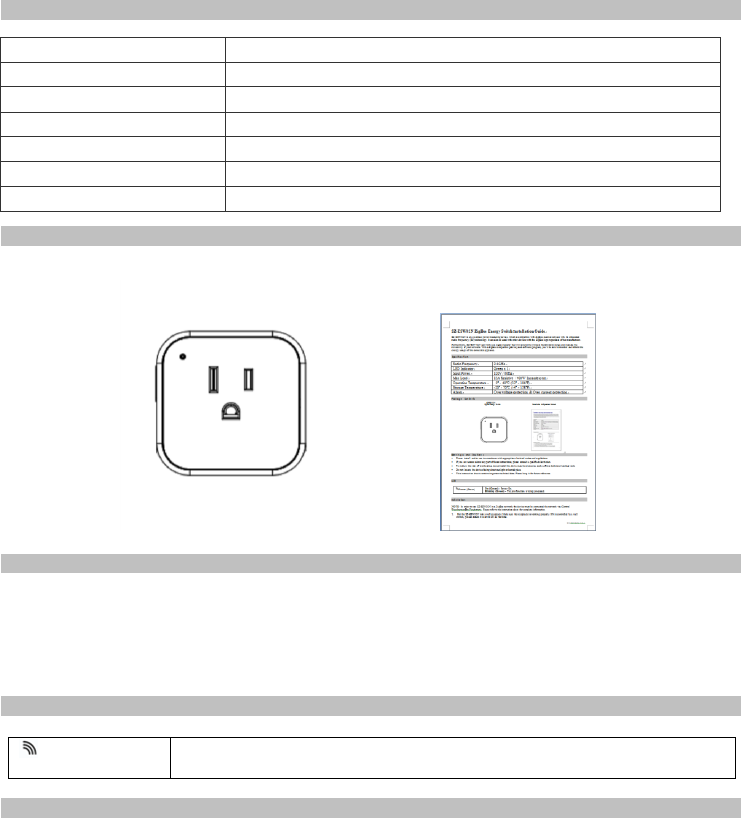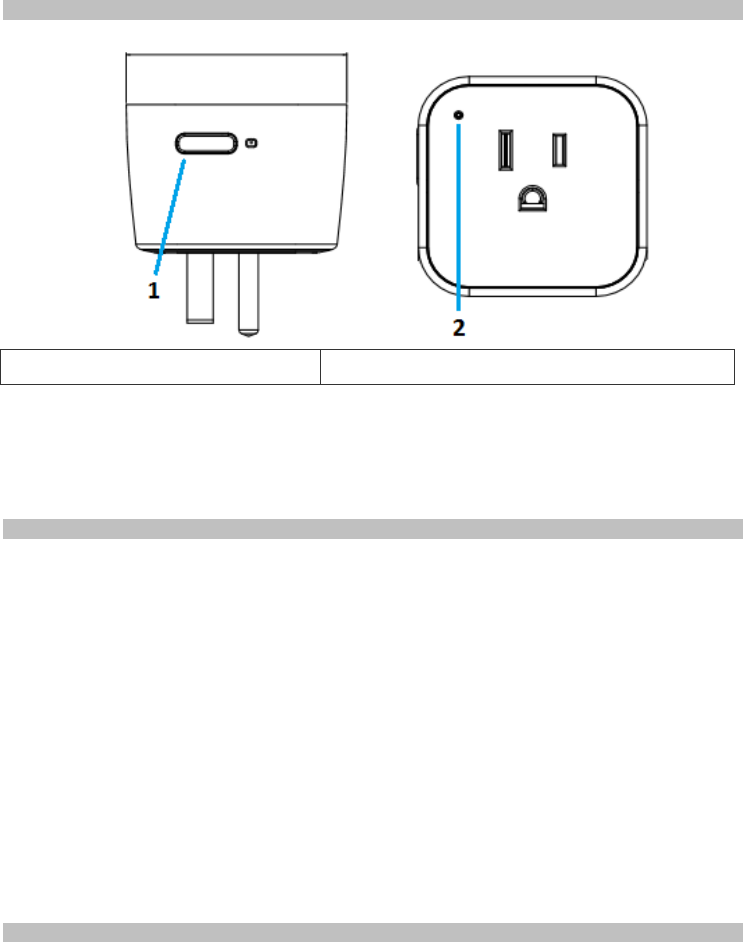Sercomm SZESW02N ZigBee Energy Switch User Manual
Sercomm Corporation ZigBee Energy Switch Users Manual
Sercomm >
Users Manual

SZ-E(B)SW02(N) V0.4
SZ-ESW02N, SZ-ESW02, SZ-BSW02N Power on/off Switch
I
nstallation
Guide
This is an electrical power measuring device, which is compatible with ZigBee enabled devices with its embedded radio
frequency (RF) technology. It can also be used with other devices with the ZigBee logo regardless of the manufacturer.
Furthermore, it can work as a signal repeater that will extend the wireless transmission range and increase the reliability of your
network. With a ZigBee compatible gateway and software program, you’ll be able to monitor and inform the energy usage of the
connected appliance.
Specification
Radio Frequency
2.4GHz
LED Indicator
Green x 1
Input Power
120V / 60Hz
Max Load
15A Resistive / 400W Incandescent
Operation Temperature
0° - 40°C (32° - 104°F)
Storage Temperature
-20° - 70°C (-4° - 158°F)
Alarm
Over voltage protection & Over current protection
Packag
e Contents
SZ-ESW02(N) or SZ-BSW02N
ZigBee Energy Switch Installation & Operation Manual
Warnings and Cautions
•
Please install and/or use in accordance with appropriate electrical codes and regulations.
•
If you are unsure about any part of these instructions, please consult a qualified electrician.
•
To reduce the risk of overheating, do not install the device near heat sources, such as fires, boilers or heating vents.
•
Do not locate the device facing direct sunlight or humid place.
•
This instruction sheet contains important technical data. Please keep it for future reference.
LED
Power (Green)
On (Green) - Power On.
Blinking (Green) - The join function is being processed.
Installation
NOTE: In order to use SZ-ESW02(N) or SZ-BSW02N in a ZigBee network, the device must be connected to the network via
ZigBee coordinator. Please refer to the instruction sheet for complete information.
1. Put the SZ-ESW02(N) or SZ-BSW02N into a wall receptacle. Make sure the receptacle is working properly. If it is
controlled by a wall switch, please ensure it is set to ON all the time.
2. Attach the appliance to the SZ-ESW02(N) or SZ-BSW02N.

SZ-E(B)SW02(N) V0.4
Operation
1. On/Off and Pairing Button
2. On/Off , Pairing and alarm LED (Green)
MANUAL Operation:
•
ON/OFF: Press this button of the device to turn the appliance on/off.
NOTE: The appliance will be turned Off regardless of its previous setting.
Join / Leave Function
Auto Joining State: A sensor that does not have a network shall search for a network that is open for joining.
1. Illuminate the LED indicator for 2 seconds to indicate a successful boot.
2. The sensor should resume scanning the next time a user-trigger occurs. This allows user interaction to cause the sensor to
resume scanning.
Joined State: A sensor that has joined shall resume the network.
1. Illuminate the LED indicator for 2 seconds to indicate a successful boot.
2. Resume operation with the existing network.
Manual Defaulting: Default a sensor puts it into a state where it is ready to be joined to a coordinator.
The process for manually default a sensor shall be as follows:
1. With the sensor powered down, press the button and hold it.
2. Power it up again. The sensor should illuminate the LED once all boot up/initialization tasks are complete.
3. Release the button while the LED has been illuminated (in 4 seconds).
4. The sensor shall then wipe any knowledge of the previous network and other configuration parameters and begin searching
for a new network(Auto Joining State).
Troubleshooting
If the device appears to be functioning improperly, please follow the suggested steps:
1. Confirm that the device is being supplied from a 120V power source.
2. Confirm that the device is being controlled in a proper way (local switch is ON).
3. Ensure that the appliance does not exceed 15A current.

SZ-E(B)SW02(N) V0.4
FCC Statement
This equipment has been tested and found to comply with the limits for a Class B digital device, pursuant to part 15
of the FCC Rules. These limits are designed to provide reasonable protection against harmful interference in a
residential installation. This equipment generates, uses and can radiate radio frequency energy and, if not installed
and used in accordance with the instructions, may cause harmful interference to radio communications. However,
there is no guarantee that interference will not occur in a particular installation. If this equipment does cause harmful
interference to radio or television reception, which can be determined by turning the equipment off and on, the user
is encouraged to try to correct the interference by one or more of the following measures:
—Reorient or relocate the receiving antenna.
—Increase the separation between the equipment and receiver.
—Connect the equipment into an outlet on a circuit different from that to which the receiver is connected.
—Consult the dealer or an experienced radio/TV technician for help.
FCC Radiation Exposure Statement
This device complies with FCC radiation exposure limits set forth for an uncontrolled environment and it also
complies with Part 15 of the FCC RF Rules. This equipment must be installed and operated in accordance with
provided instructions and the antenna(s) used for this transmitter must be installed to provide a separation distance
of at least 20 cm from all persons and must not be co-located or operating in conjunction with any other antenna or
transmitter. End-users and installers must be provide with antenna installation instructions and consider removing
the no-collocation statement.
This device complies with Part 15 of the FCC Rules. Operation is subject to the following two conditions: (1) this
device may not cause harmful interference, and (2) this device must accept any interference received, including
interference that may cause undesired operation.
Caution!
Any changes or modifications not expressly approved by the party responsible for compliance could void the user's
authority to operate the equipment.

SZ-E(B)SW02(N) V0.4
Canada Statement
This device complies with Industry Canada’s licence-exempt RSSs. Operation is subject to the following two
conditions:
(1) This device may not cause interference; and
(2) This device must accept any interference, including interference that may cause undesired operation of the
device.
Le présent appareil est conforme aux CNR d’Industrie Canada applicables aux appareils radio exempts de licence.
L’exploitation est autorisée aux deux conditions suivantes :
(1) l’appareil ne doit pas produire de brouillage;
(2) l’utilisateur de l’appareil doit accepter tout brouillage radioélectrique subi, même si le brouillage est susceptible
d’en compromettre le fonctionnement.
The device meets the exemption from the routine evaluation limits in section 2.5 of RSS 102 and compliance with
RSS-102 RF exposure, users can obtain Canadian information on RF exposure and compliance.
Le dispositif rencontre l'exemption des limites courantes d'évaluation dans la section 2.5 de RSS 102 et la
conformité à l'exposition de RSS-102 rf, utilisateurs peut obtenir l'information canadienne sur l'exposition et la
conformité de rf.
This transmitter must not be co-located or operating in conjunction with any other antenna or transmitter. This
equipment should be installed and operated with a minimum distance of 20 centimeters between the radiator and
your body.
Cet émetteur ne doit pas être Co-placé ou ne fonctionnant en même temps qu'aucune autre antenne ou émetteur. Cet
équipement devrait être installé et actionné avec une distance minimum de 20 centimètres entre le radiateur et votre
corps.